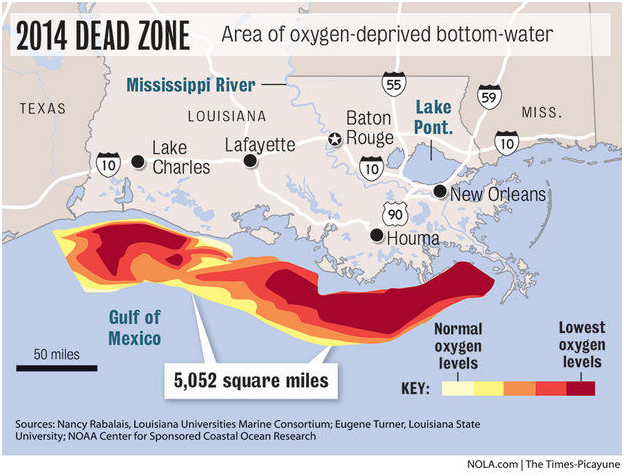Global warming likely worsening ‘dead zone’ in Gulf of Mexico, study finds
By Associated PressNovember 10, 2014

Global warming is likely playing a bigger role than previously thought in dead zones in oceans, lakes and rivers around the world and it’s only going to get worse, according to a new study.
Dead zones occur when fertilizer runoff clogs waterways with nutrients, such as nitrogen and phosphorous. That leads to an explosion of microbes that consumes oxygen and leaves the water depleted of oxygen, harming marine life.
Scientists have long known that warmer water increases this problem, but a new study Monday in the journal Global Change Biology by Smithsonian Institution researchers found about two dozen different ways — biologically, chemically and physically — that climate change worsens the oxygen depletion.
"We’ve underestimated the effect of climate change on dead zones," said study lead author Andrew Altieri, a researcher at the Smithsonian’s tropical center in Panama.
The researchers looked at 476 dead zones worldwide— 264 in the United States. They found that standard computer climate models predict that, on average, the surface temperature around those dead zones will increase by about 4 degrees Fahrenheit (slightly more than 2 degrees Celsius) from the 1980s and 1990s to the end of this century.
The largest predicted warming is nearly 7 degrees (almost 4 degrees Celsius) where the St. Lawrence River dumps into the ocean in Canada. The most prominent U.S. dead zones, the Gulf of Mexico and the Chesapeake Bay, are projected to warm 4 degrees (2.3 degrees Celsius) and nearly 5 degrees (2.7 degrees Celsius) respectively.
• This year’s "dead zone" along Louisiana coast covered 5,052 square miles, an area the size of the state of Connecticut but about 800 square miles less than the 2013 dead zone. Read more.
Warmer water holds less oxygen, adding to the problem from runoff, said co-author Keryn Gedan, who is at both the Smithsonian and the University of Maryland. But warmer water also affects dead zones by keeping the water more separate, so that oxygen-poor deep water mixes less.
"It’s like Italian dressing that you haven’t shaken, where you have the oil and water separate," Altieri said.
When the water gets warmer, marine life’s metabolism increases, making them require more oxygen just as the oxygen levels are already dropping. Other ways that climate change affects dead zones includes longer summers, ocean acidification and changing wind and current patterns, the study said.
Donald Boesch, a University of Maryland ecologist who wasn’t part of the study and works at a different department than Gedan, said there is not enough evidence to say that climate change has already played such a big role in the spread of dead zones. But he said the study is probably right in warning that future warming will make the problem even worse.
http://www.nola.com/environment/index.ssf/2014/11/global_warming_dead_zone_study.html
